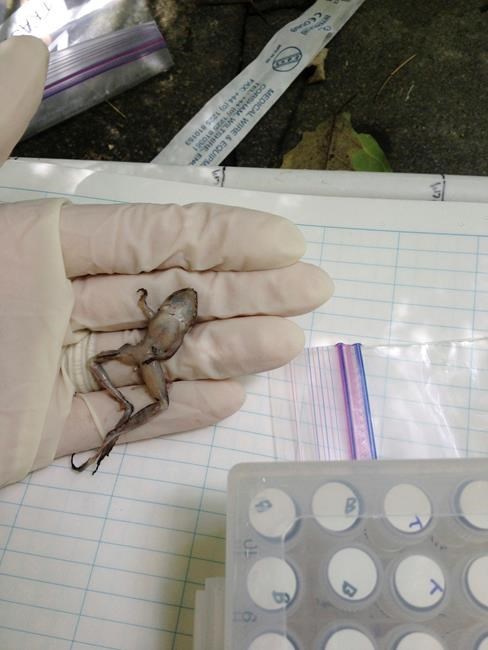
In this undated photo provided by Jamie Voyles in March 2018, a researcher holds a dead frog in Panama. A deadly fungal disease devastated amphibians in Central America more than a decade ago, quieting some mountain streams. But new research released on Thursday, March 28, 2018 shows evolution may have saved the day _ and the frogs. (Jamie Voyles/via AP)
March 29, 2018 - 11:28 AM
WASHINGTON - After years of silence, the rhythmic dee-dee-deeps of frogs and toads are returning in parts of Panama.
A deadly fungal disease devastated amphibians in Central America more than a decade ago, quieting some mountain streams. But new research shows evolution may have saved the day — and the frogs.
In El Cope, Panama, at least four species disappeared including the red-striped Rio San Juan robber frog. Four other species lost at least 88 per cent of their population from a disease-causing fungus that hit Panama hard from 2004 to 2007. The fungus has also been blamed for wiping out amphibian populations in California's Sierra Nevada and parts of Australia.
In the last few years, croaks have been heard in once quiet Panama streams. The critters are by no means recovered since they are still infected with the fungus, but they are alive and growing in numbers, according to a new study in Thursday's journal Science .
"It's so easy to lose hope when you've walked the same stretch of stream year after year, hoping to see a hint of the amazing diversity you once saw there," study co-author Corinne Richards-Zawacki, a University of Pittsburgh biologist, said in an email. "So you can imagine how good it feels to be able to report some good news from the field."
The recovery is not everywhere and it's at best modest, cautioned lead author Jamie Voyles, a disease ecologist at the University of Nevada, Reno. One of the frogs making the most noticeable comeback is the hard-to-catch rocket frog, named because it is so quick, she said.
Voyles and Richards-Zawacki wanted to find out why the amphibians survived. They initially figured the disease weakened. But after testing old and new disease samples on frogs, they found the disease was as dangerous as ever.
To their surprise, the frogs and toads were fighting back better. The fungal disease attacks their skin secretions and recently the frogs showed a two- to five-fold improvement in the amphibians' ability to limit the fungus' growth. The disease is still there, but it does less damage, Voyles said.
While this research is important, the findings aren't too surprising because past studies have shown that as bad as disease outbreaks get, they play a tiny role in species extinction, said Andrew Blaustein at Oregon State University, who wasn't part of the study.
Evolution allows species to resist completely succumbing to the nastiest diseases. "So, yes there is hope," Blaustein said in an email.
___
Follow Seth Borenstein on Twitter at @borenbears . His work can be found here .
___
The Associated Press Health & Science Department receives support from the Howard Hughes Medical Institute's Department of Science Education. The AP is solely responsible for all content.
News from © The Associated Press, 2018